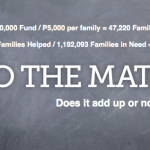Do the math: P238.6M Typhoon Fund Release will help only 47,000 of the 1,192,093 displaced families
There are times when you really have to pause, think, and DO THE MATH. This is one such time.
The Philippine government on December 11 announced the release of P238.6M ($5.6M) for housing aid for Typhoon Yolanda victims under the Housing Materials Assistance (HOMA) program, saying that this program will provide P5,000 in housing materials “for every family whose home was partially damaged by calamities, but who will not require resettlement.”
This is a good thing, and is a step in the right direction.
The “takeaway” from the release is that the P238.6M actually does that — gives P5,000 to each family in need.
But does it?
Let’s do the math.
P238.6M is to be used at a rate of P5,000 per household that has suffered a partially damaged home but does not need resettlement.
So how many homes is that?
P238.6M x P5,000 = 47,720 homes.
But how many homes are we talking about to reach everyone in need after Yolanda?
Well, elsewhere, the NDRRMC gave the following numbers yesterday for destroyed and damaged homes:
- 593,787 Destroyed
- 598,306 Damaged
- Altogether — 1,192, 093 destroyed or damaged homes
Time for some more arithmetic.
47,720 homes = 4% of 1,092,093.
So that’s it — the P238.6M will yield P5,000 for 47,720 families, or 4% of the families in need after Yolanda.
Don’t get me wrong — 4% is a start. But numbers only have meaning when you actually take the time and expend the effort to crunch them — if you just hear “P239M” it sounds like a lot, and then when you read a statement that says it will provide P5,000 “for every family” maybe you just accept on face value that the P239M will in fact yield P5,000 per family.
But this is money, not loaves and fishes, and it doesn’t add up.
And by the way, I’m not picking on the Philipping government as if they are the only ones who do this. Far from it. US Politicians and the US Government does the same thing when announcing release of funds to disaster stricken areas. They leave it up to the reader to “do the math”.
So we must do the math.
Bottom line is that the P238.6M is a good start but that’s all it is — a start.
It’s 8% of what is needed to provide P5,000 to “every family whose home was partially damaged by calamities, but who will not require resettlement.”
And then, there is the “resettlement” issue . . .
Let’s look at that.
The release says that:
- The full P239M is for HOMA assistance at P5,000 per family
- The P239M is part of a larger 350M EHACVP program (a crazy acronym for emergency housing for calamity victims)
- Thus there is an additional P111M a(239 + 111 = 350) but this is earmarked for for “households affected by previous calamities, including typhoons Vinta, Santi, Laguyo, Yolanda, Quinta, and Pablo, as well as other disasters, such as fires and earthquakes. –
- And, regarding the P111M: “Under the program, beneficiaries will be relocated to permanent dwellings in safe areas.”
Again — do the math:
P111M would, if it was applied solely to the Yolanda victims whose homes were totally destroyed, yield exactly P187 per family, which is obviously not enough to resettle a family.
But it’s not being applied solely to Yolanda victims — it’s for “households affected by previous calamities”….
And finally — what about the idea of resettling people to “permanent dwellings in safe areas”.
Resettlement is a pretty delicate matter.
People don’t generally want to be moved away from their home area.
Does this refer to moving someone a few hundred meters away from the coastline?
Or to someplace altogether different?
Lots of questions.
I’m not saying what the goverment is doing is bad, or that the government has been egregiously misleading.
I’m just saying that it’s up to everybody who has homeless families to worry about (as we do) or who has a stake in the situation some other way — it’s up to all of us to do the math and ask the questions, and if possible try and contribute to solutions.
I’ll come back to where I started — P238.6M is a good start but it only reaches 4% of those in need.
Much, much more is needed and it’s not just up to the Philippine government to provide it.
It’s up to everyone — governments, NGOs, ordinary people.
The work has hardly begun.
Year of the Spy Book Trailer
Above is the Year of the Spy Book Trailer — for my upcoming non-fiction book about espionage upheavals on the streets of Moscow in 1985.
Below is a “trailer” showcasing the writing and video services I provide to clients.
Michael Sellers — Writing and Video Services
My eBook — Just released Dec 5, 2012
EBook You don't need a Kindle or iPad -- Download Adobe Digital Editions for Free, then read the .mobi (Kindle Format) or .epub (Nook, iPad Format) digital book on your computer. Or order the PDF which is formatted exactly like the print book.Recent Posts
- Arsha Sellers — Today I’m One Big Step Closer to Becoming a Real Forever Dad
- Meet Abby Sellers and Arshavin Sellers — My Wife, My Son, My Inspiration Every Day
- What the Mueller Report Actually Says
- Remembering James Blount, an American Who “Got” the Philippines in 1901
- America the Beautiful? You Mean America the Pitiful. I Am Ashamed





